Strategies for Supporting Students with ADHD and Dyslexia Effectively
VerifiedAdded on 2023/06/13
|10
|3199
|151
Report
AI Summary
This report provides an overview of strategies for supporting a 9-year-old student with ADHD and dyslexia. It emphasizes the importance of organizational skills, sensitivity, and positive relationships between educators and students. The report outlines specific implementation techniques such as using mind maps, scaffolding theory, and mathematical resources to improve organizational skills and learning outcomes. It also highlights the need for empathy and responsive communication to address the unique challenges faced by students with these conditions. Furthermore, the report discusses the benefits of fostering positive relationships to prevent behavioral issues and create a supportive learning environment. The document is available on Desklib, a platform offering a range of study tools and resources for students.
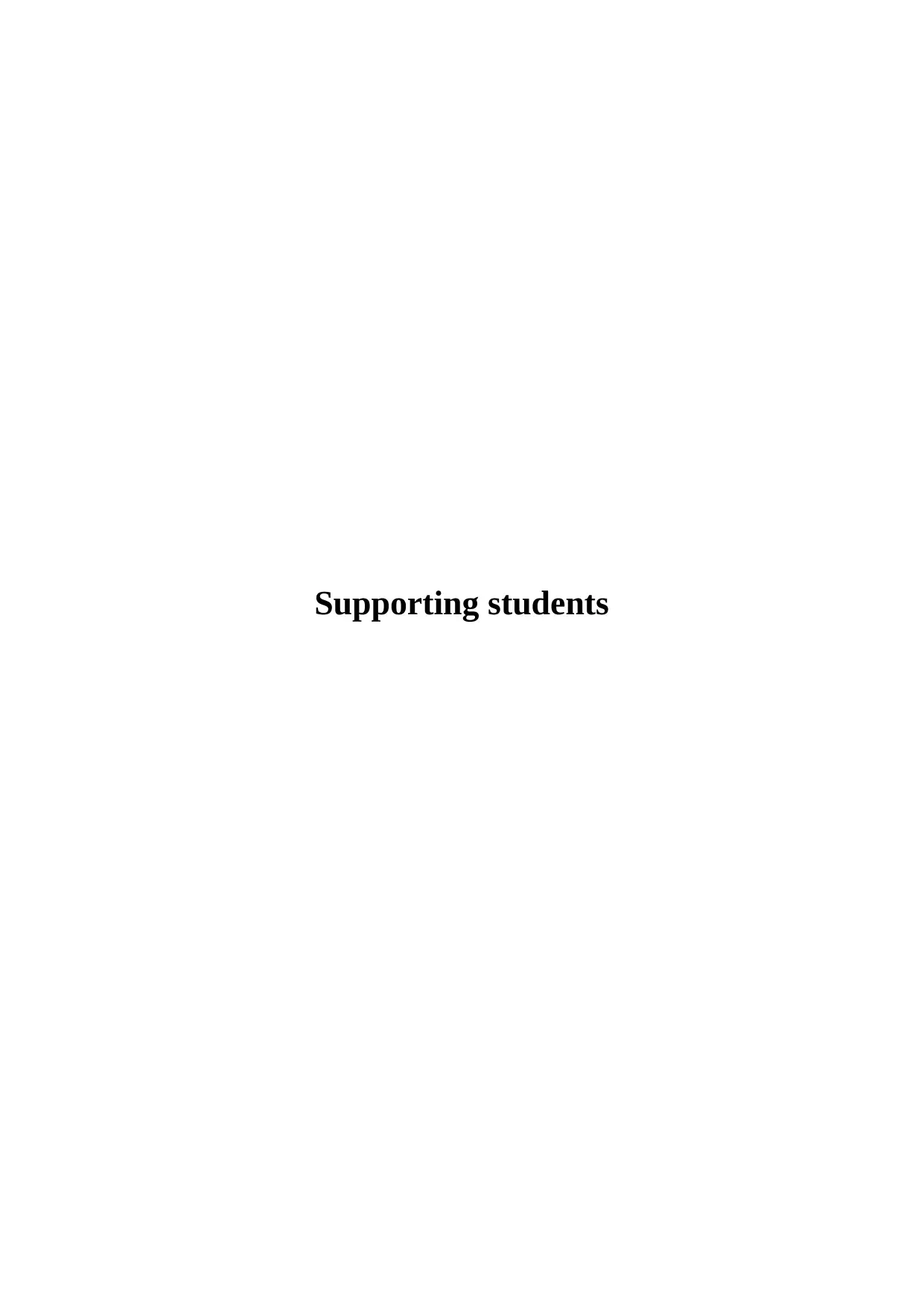
Supporting students
Paraphrase This Document
Need a fresh take? Get an instant paraphrase of this document with our AI Paraphraser
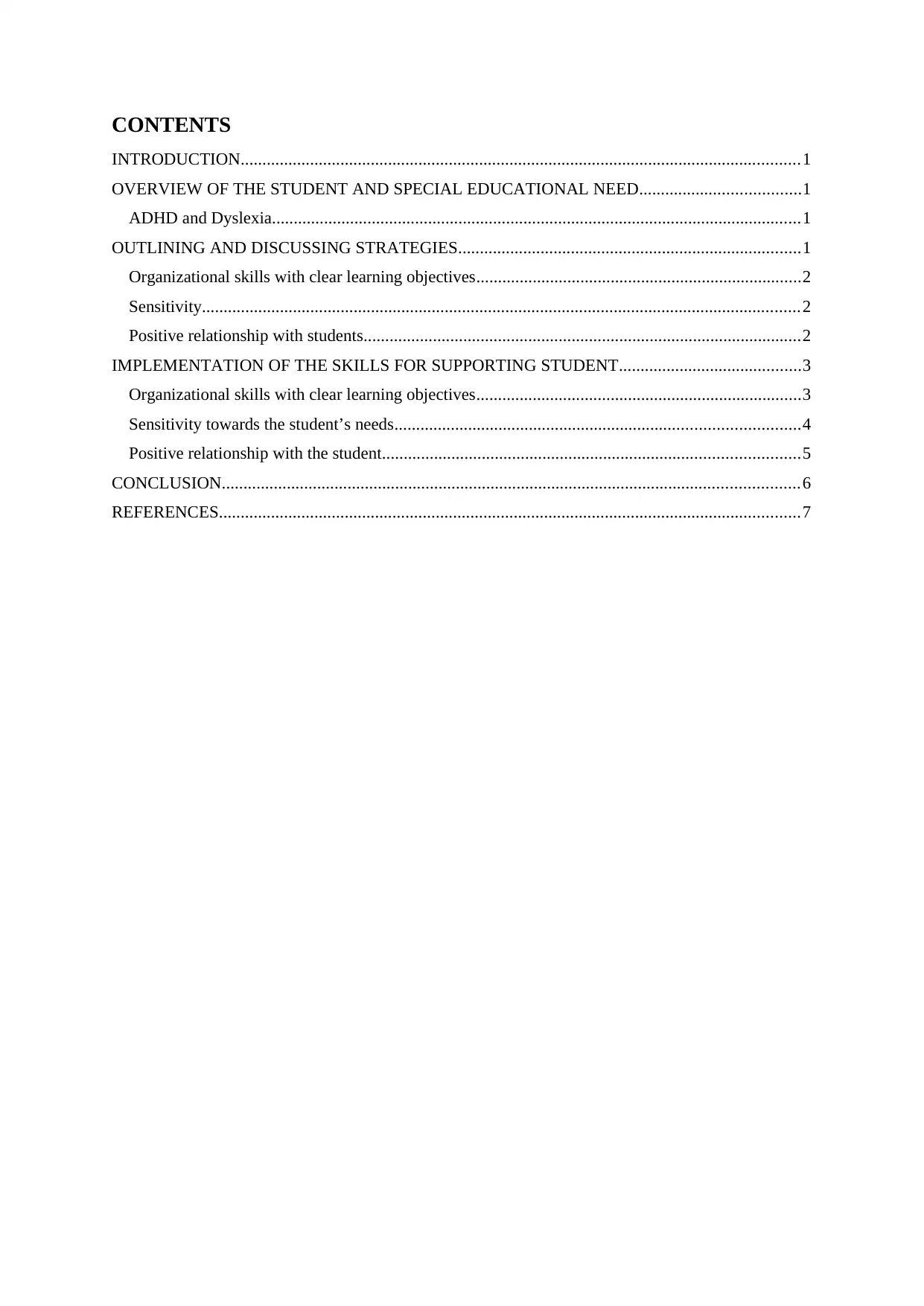
CONTENTS
INTRODUCTION.................................................................................................................................1
OVERVIEW OF THE STUDENT AND SPECIAL EDUCATIONAL NEED.....................................1
ADHD and Dyslexia..........................................................................................................................1
OUTLINING AND DISCUSSING STRATEGIES...............................................................................1
Organizational skills with clear learning objectives...........................................................................2
Sensitivity..........................................................................................................................................2
Positive relationship with students.....................................................................................................2
IMPLEMENTATION OF THE SKILLS FOR SUPPORTING STUDENT..........................................3
Organizational skills with clear learning objectives...........................................................................3
Sensitivity towards the student’s needs.............................................................................................4
Positive relationship with the student................................................................................................5
CONCLUSION.....................................................................................................................................6
REFERENCES......................................................................................................................................7
INTRODUCTION.................................................................................................................................1
OVERVIEW OF THE STUDENT AND SPECIAL EDUCATIONAL NEED.....................................1
ADHD and Dyslexia..........................................................................................................................1
OUTLINING AND DISCUSSING STRATEGIES...............................................................................1
Organizational skills with clear learning objectives...........................................................................2
Sensitivity..........................................................................................................................................2
Positive relationship with students.....................................................................................................2
IMPLEMENTATION OF THE SKILLS FOR SUPPORTING STUDENT..........................................3
Organizational skills with clear learning objectives...........................................................................3
Sensitivity towards the student’s needs.............................................................................................4
Positive relationship with the student................................................................................................5
CONCLUSION.....................................................................................................................................6
REFERENCES......................................................................................................................................7
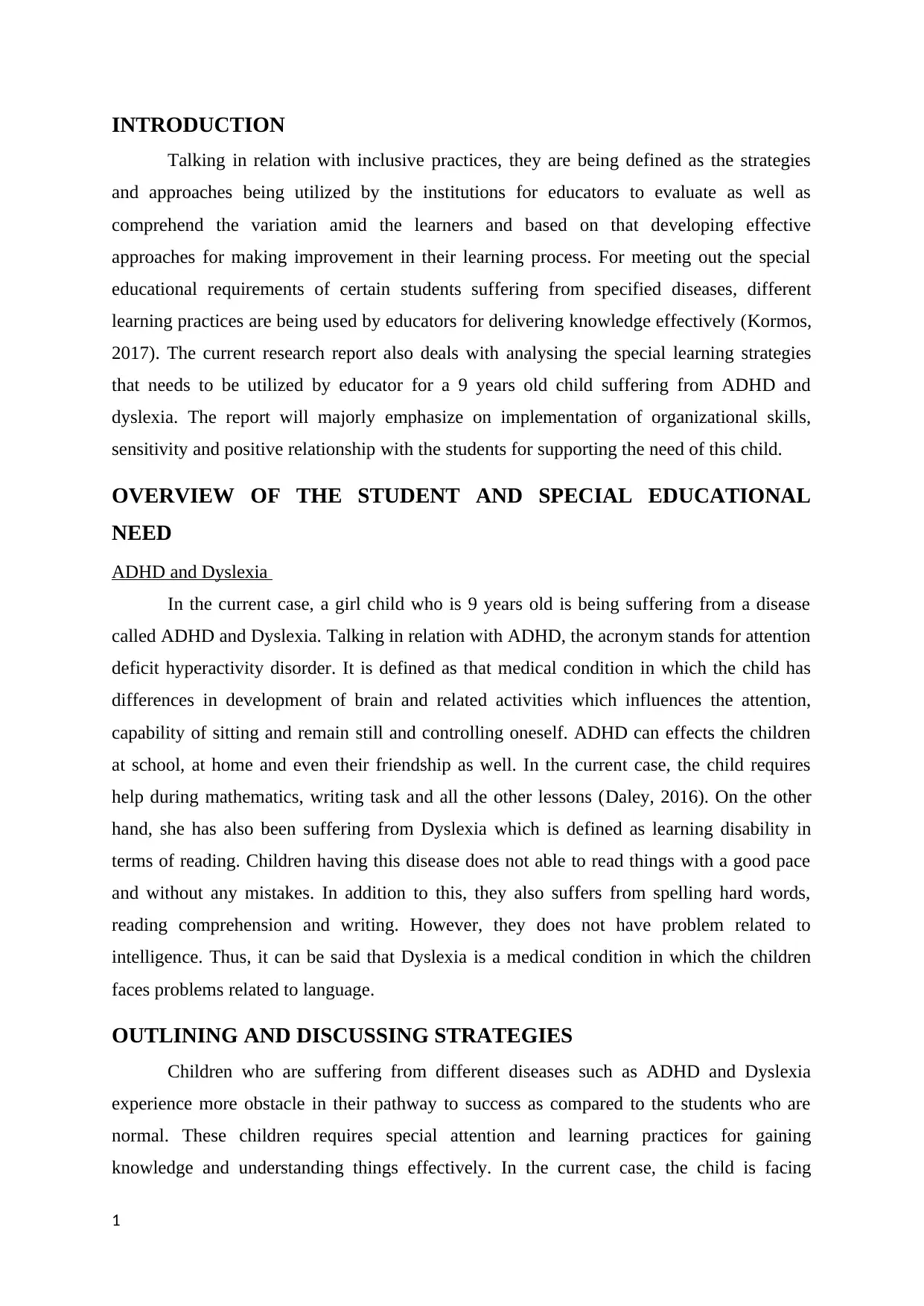
INTRODUCTION
Talking in relation with inclusive practices, they are being defined as the strategies
and approaches being utilized by the institutions for educators to evaluate as well as
comprehend the variation amid the learners and based on that developing effective
approaches for making improvement in their learning process. For meeting out the special
educational requirements of certain students suffering from specified diseases, different
learning practices are being used by educators for delivering knowledge effectively (Kormos,
2017). The current research report also deals with analysing the special learning strategies
that needs to be utilized by educator for a 9 years old child suffering from ADHD and
dyslexia. The report will majorly emphasize on implementation of organizational skills,
sensitivity and positive relationship with the students for supporting the need of this child.
OVERVIEW OF THE STUDENT AND SPECIAL EDUCATIONAL
NEED
ADHD and Dyslexia
In the current case, a girl child who is 9 years old is being suffering from a disease
called ADHD and Dyslexia. Talking in relation with ADHD, the acronym stands for attention
deficit hyperactivity disorder. It is defined as that medical condition in which the child has
differences in development of brain and related activities which influences the attention,
capability of sitting and remain still and controlling oneself. ADHD can effects the children
at school, at home and even their friendship as well. In the current case, the child requires
help during mathematics, writing task and all the other lessons (Daley, 2016). On the other
hand, she has also been suffering from Dyslexia which is defined as learning disability in
terms of reading. Children having this disease does not able to read things with a good pace
and without any mistakes. In addition to this, they also suffers from spelling hard words,
reading comprehension and writing. However, they does not have problem related to
intelligence. Thus, it can be said that Dyslexia is a medical condition in which the children
faces problems related to language.
OUTLINING AND DISCUSSING STRATEGIES
Children who are suffering from different diseases such as ADHD and Dyslexia
experience more obstacle in their pathway to success as compared to the students who are
normal. These children requires special attention and learning practices for gaining
knowledge and understanding things effectively. In the current case, the child is facing
1
Talking in relation with inclusive practices, they are being defined as the strategies
and approaches being utilized by the institutions for educators to evaluate as well as
comprehend the variation amid the learners and based on that developing effective
approaches for making improvement in their learning process. For meeting out the special
educational requirements of certain students suffering from specified diseases, different
learning practices are being used by educators for delivering knowledge effectively (Kormos,
2017). The current research report also deals with analysing the special learning strategies
that needs to be utilized by educator for a 9 years old child suffering from ADHD and
dyslexia. The report will majorly emphasize on implementation of organizational skills,
sensitivity and positive relationship with the students for supporting the need of this child.
OVERVIEW OF THE STUDENT AND SPECIAL EDUCATIONAL
NEED
ADHD and Dyslexia
In the current case, a girl child who is 9 years old is being suffering from a disease
called ADHD and Dyslexia. Talking in relation with ADHD, the acronym stands for attention
deficit hyperactivity disorder. It is defined as that medical condition in which the child has
differences in development of brain and related activities which influences the attention,
capability of sitting and remain still and controlling oneself. ADHD can effects the children
at school, at home and even their friendship as well. In the current case, the child requires
help during mathematics, writing task and all the other lessons (Daley, 2016). On the other
hand, she has also been suffering from Dyslexia which is defined as learning disability in
terms of reading. Children having this disease does not able to read things with a good pace
and without any mistakes. In addition to this, they also suffers from spelling hard words,
reading comprehension and writing. However, they does not have problem related to
intelligence. Thus, it can be said that Dyslexia is a medical condition in which the children
faces problems related to language.
OUTLINING AND DISCUSSING STRATEGIES
Children who are suffering from different diseases such as ADHD and Dyslexia
experience more obstacle in their pathway to success as compared to the students who are
normal. These children requires special attention and learning practices for gaining
knowledge and understanding things effectively. In the current case, the child is facing
1
⊘ This is a preview!⊘
Do you want full access?
Subscribe today to unlock all pages.

Trusted by 1+ million students worldwide
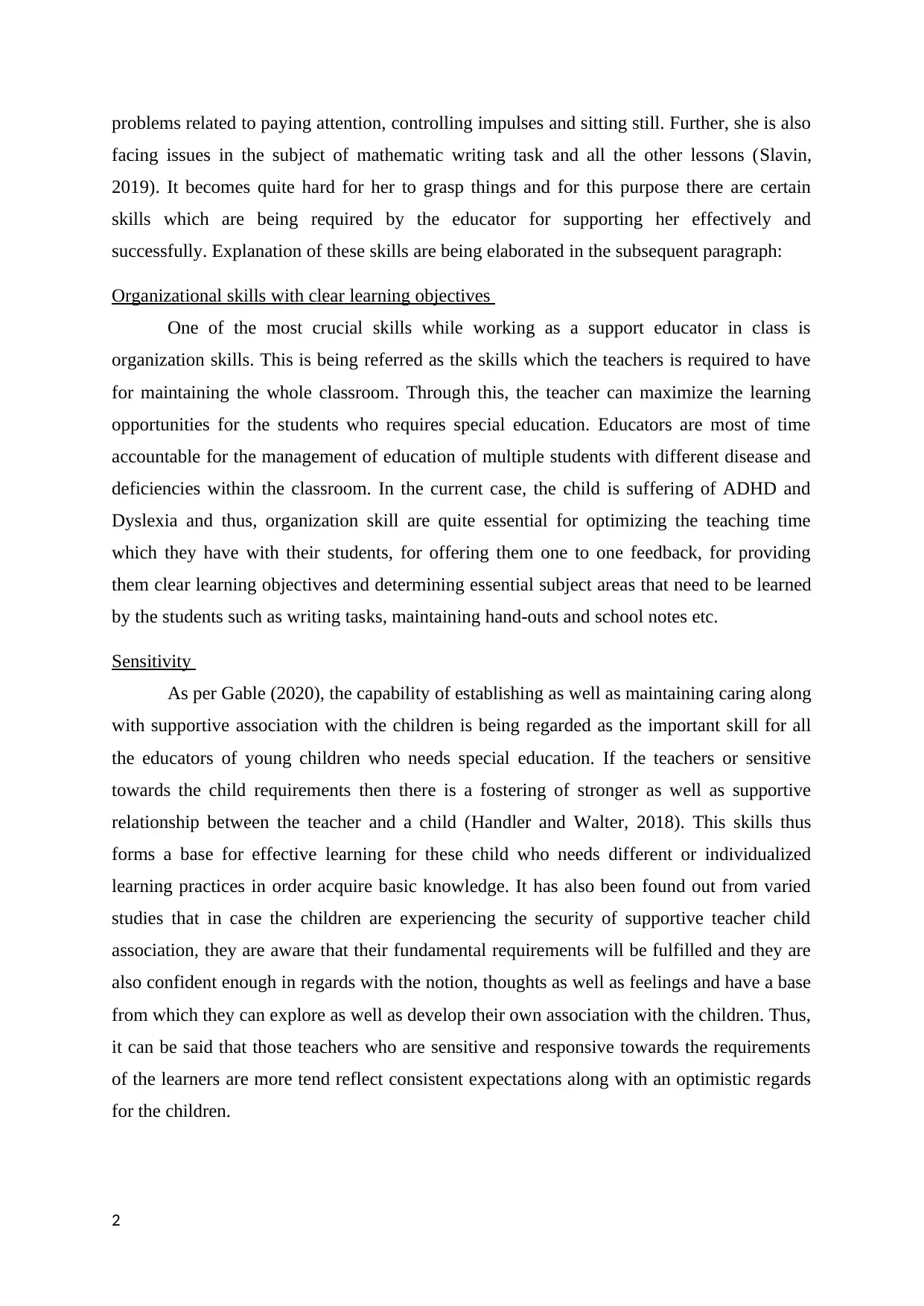
problems related to paying attention, controlling impulses and sitting still. Further, she is also
facing issues in the subject of mathematic writing task and all the other lessons (Slavin,
2019). It becomes quite hard for her to grasp things and for this purpose there are certain
skills which are being required by the educator for supporting her effectively and
successfully. Explanation of these skills are being elaborated in the subsequent paragraph:
Organizational skills with clear learning objectives
One of the most crucial skills while working as a support educator in class is
organization skills. This is being referred as the skills which the teachers is required to have
for maintaining the whole classroom. Through this, the teacher can maximize the learning
opportunities for the students who requires special education. Educators are most of time
accountable for the management of education of multiple students with different disease and
deficiencies within the classroom. In the current case, the child is suffering of ADHD and
Dyslexia and thus, organization skill are quite essential for optimizing the teaching time
which they have with their students, for offering them one to one feedback, for providing
them clear learning objectives and determining essential subject areas that need to be learned
by the students such as writing tasks, maintaining hand-outs and school notes etc.
Sensitivity
As per Gable (2020), the capability of establishing as well as maintaining caring along
with supportive association with the children is being regarded as the important skill for all
the educators of young children who needs special education. If the teachers or sensitive
towards the child requirements then there is a fostering of stronger as well as supportive
relationship between the teacher and a child (Handler and Walter, 2018). This skills thus
forms a base for effective learning for these child who needs different or individualized
learning practices in order acquire basic knowledge. It has also been found out from varied
studies that in case the children are experiencing the security of supportive teacher child
association, they are aware that their fundamental requirements will be fulfilled and they are
also confident enough in regards with the notion, thoughts as well as feelings and have a base
from which they can explore as well as develop their own association with the children. Thus,
it can be said that those teachers who are sensitive and responsive towards the requirements
of the learners are more tend reflect consistent expectations along with an optimistic regards
for the children.
2
facing issues in the subject of mathematic writing task and all the other lessons (Slavin,
2019). It becomes quite hard for her to grasp things and for this purpose there are certain
skills which are being required by the educator for supporting her effectively and
successfully. Explanation of these skills are being elaborated in the subsequent paragraph:
Organizational skills with clear learning objectives
One of the most crucial skills while working as a support educator in class is
organization skills. This is being referred as the skills which the teachers is required to have
for maintaining the whole classroom. Through this, the teacher can maximize the learning
opportunities for the students who requires special education. Educators are most of time
accountable for the management of education of multiple students with different disease and
deficiencies within the classroom. In the current case, the child is suffering of ADHD and
Dyslexia and thus, organization skill are quite essential for optimizing the teaching time
which they have with their students, for offering them one to one feedback, for providing
them clear learning objectives and determining essential subject areas that need to be learned
by the students such as writing tasks, maintaining hand-outs and school notes etc.
Sensitivity
As per Gable (2020), the capability of establishing as well as maintaining caring along
with supportive association with the children is being regarded as the important skill for all
the educators of young children who needs special education. If the teachers or sensitive
towards the child requirements then there is a fostering of stronger as well as supportive
relationship between the teacher and a child (Handler and Walter, 2018). This skills thus
forms a base for effective learning for these child who needs different or individualized
learning practices in order acquire basic knowledge. It has also been found out from varied
studies that in case the children are experiencing the security of supportive teacher child
association, they are aware that their fundamental requirements will be fulfilled and they are
also confident enough in regards with the notion, thoughts as well as feelings and have a base
from which they can explore as well as develop their own association with the children. Thus,
it can be said that those teachers who are sensitive and responsive towards the requirements
of the learners are more tend reflect consistent expectations along with an optimistic regards
for the children.
2
Paraphrase This Document
Need a fresh take? Get an instant paraphrase of this document with our AI Paraphraser
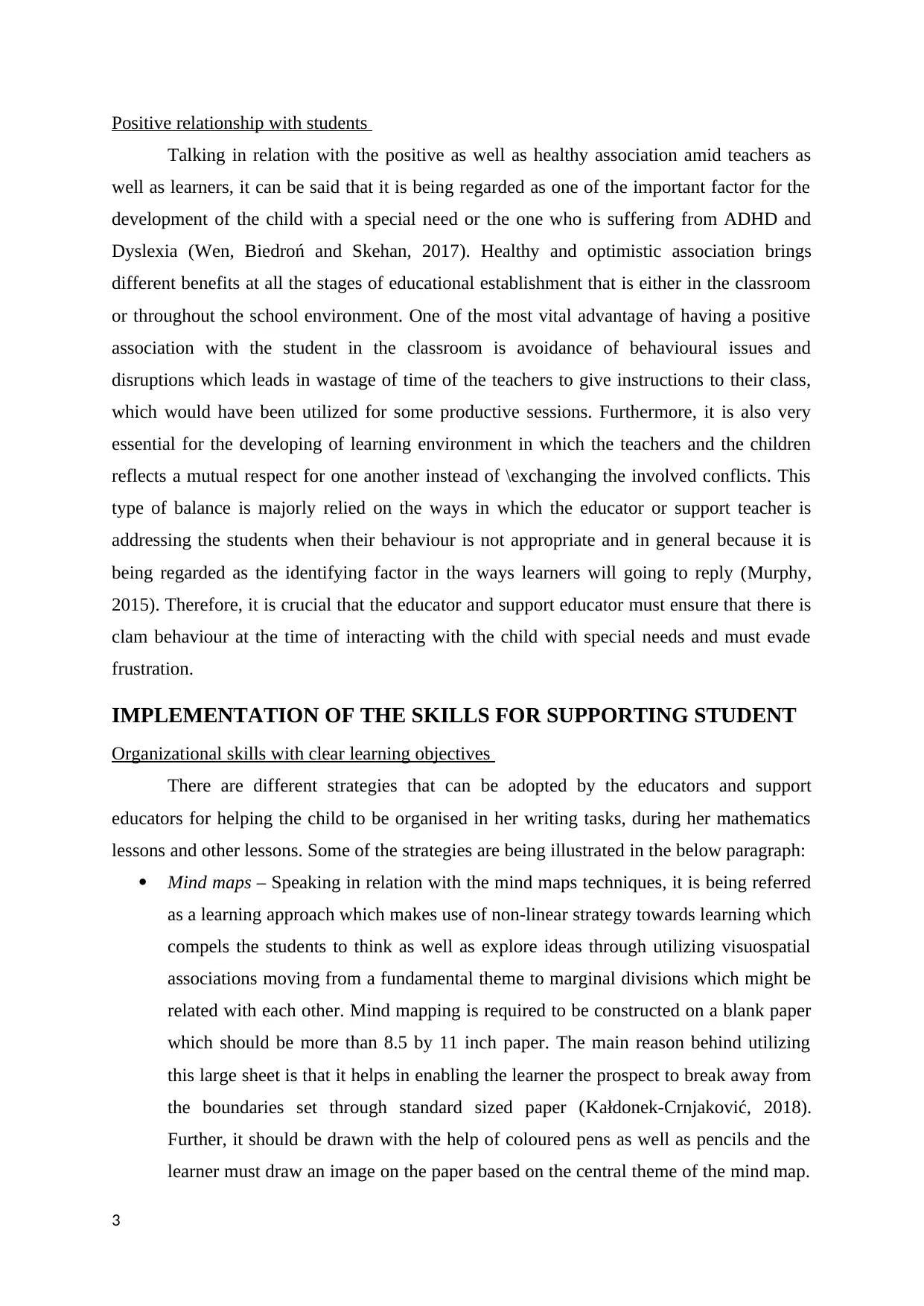
Positive relationship with students
Talking in relation with the positive as well as healthy association amid teachers as
well as learners, it can be said that it is being regarded as one of the important factor for the
development of the child with a special need or the one who is suffering from ADHD and
Dyslexia (Wen, Biedroń and Skehan, 2017). Healthy and optimistic association brings
different benefits at all the stages of educational establishment that is either in the classroom
or throughout the school environment. One of the most vital advantage of having a positive
association with the student in the classroom is avoidance of behavioural issues and
disruptions which leads in wastage of time of the teachers to give instructions to their class,
which would have been utilized for some productive sessions. Furthermore, it is also very
essential for the developing of learning environment in which the teachers and the children
reflects a mutual respect for one another instead of \exchanging the involved conflicts. This
type of balance is majorly relied on the ways in which the educator or support teacher is
addressing the students when their behaviour is not appropriate and in general because it is
being regarded as the identifying factor in the ways learners will going to reply (Murphy,
2015). Therefore, it is crucial that the educator and support educator must ensure that there is
clam behaviour at the time of interacting with the child with special needs and must evade
frustration.
IMPLEMENTATION OF THE SKILLS FOR SUPPORTING STUDENT
Organizational skills with clear learning objectives
There are different strategies that can be adopted by the educators and support
educators for helping the child to be organised in her writing tasks, during her mathematics
lessons and other lessons. Some of the strategies are being illustrated in the below paragraph:
Mind maps – Speaking in relation with the mind maps techniques, it is being referred
as a learning approach which makes use of non-linear strategy towards learning which
compels the students to think as well as explore ideas through utilizing visuospatial
associations moving from a fundamental theme to marginal divisions which might be
related with each other. Mind mapping is required to be constructed on a blank paper
which should be more than 8.5 by 11 inch paper. The main reason behind utilizing
this large sheet is that it helps in enabling the learner the prospect to break away from
the boundaries set through standard sized paper (Kałdonek-Crnjaković, 2018).
Further, it should be drawn with the help of coloured pens as well as pencils and the
learner must draw an image on the paper based on the central theme of the mind map.
3
Talking in relation with the positive as well as healthy association amid teachers as
well as learners, it can be said that it is being regarded as one of the important factor for the
development of the child with a special need or the one who is suffering from ADHD and
Dyslexia (Wen, Biedroń and Skehan, 2017). Healthy and optimistic association brings
different benefits at all the stages of educational establishment that is either in the classroom
or throughout the school environment. One of the most vital advantage of having a positive
association with the student in the classroom is avoidance of behavioural issues and
disruptions which leads in wastage of time of the teachers to give instructions to their class,
which would have been utilized for some productive sessions. Furthermore, it is also very
essential for the developing of learning environment in which the teachers and the children
reflects a mutual respect for one another instead of \exchanging the involved conflicts. This
type of balance is majorly relied on the ways in which the educator or support teacher is
addressing the students when their behaviour is not appropriate and in general because it is
being regarded as the identifying factor in the ways learners will going to reply (Murphy,
2015). Therefore, it is crucial that the educator and support educator must ensure that there is
clam behaviour at the time of interacting with the child with special needs and must evade
frustration.
IMPLEMENTATION OF THE SKILLS FOR SUPPORTING STUDENT
Organizational skills with clear learning objectives
There are different strategies that can be adopted by the educators and support
educators for helping the child to be organised in her writing tasks, during her mathematics
lessons and other lessons. Some of the strategies are being illustrated in the below paragraph:
Mind maps – Speaking in relation with the mind maps techniques, it is being referred
as a learning approach which makes use of non-linear strategy towards learning which
compels the students to think as well as explore ideas through utilizing visuospatial
associations moving from a fundamental theme to marginal divisions which might be
related with each other. Mind mapping is required to be constructed on a blank paper
which should be more than 8.5 by 11 inch paper. The main reason behind utilizing
this large sheet is that it helps in enabling the learner the prospect to break away from
the boundaries set through standard sized paper (Kałdonek-Crnjaković, 2018).
Further, it should be drawn with the help of coloured pens as well as pencils and the
learner must draw an image on the paper based on the central theme of the mind map.
3
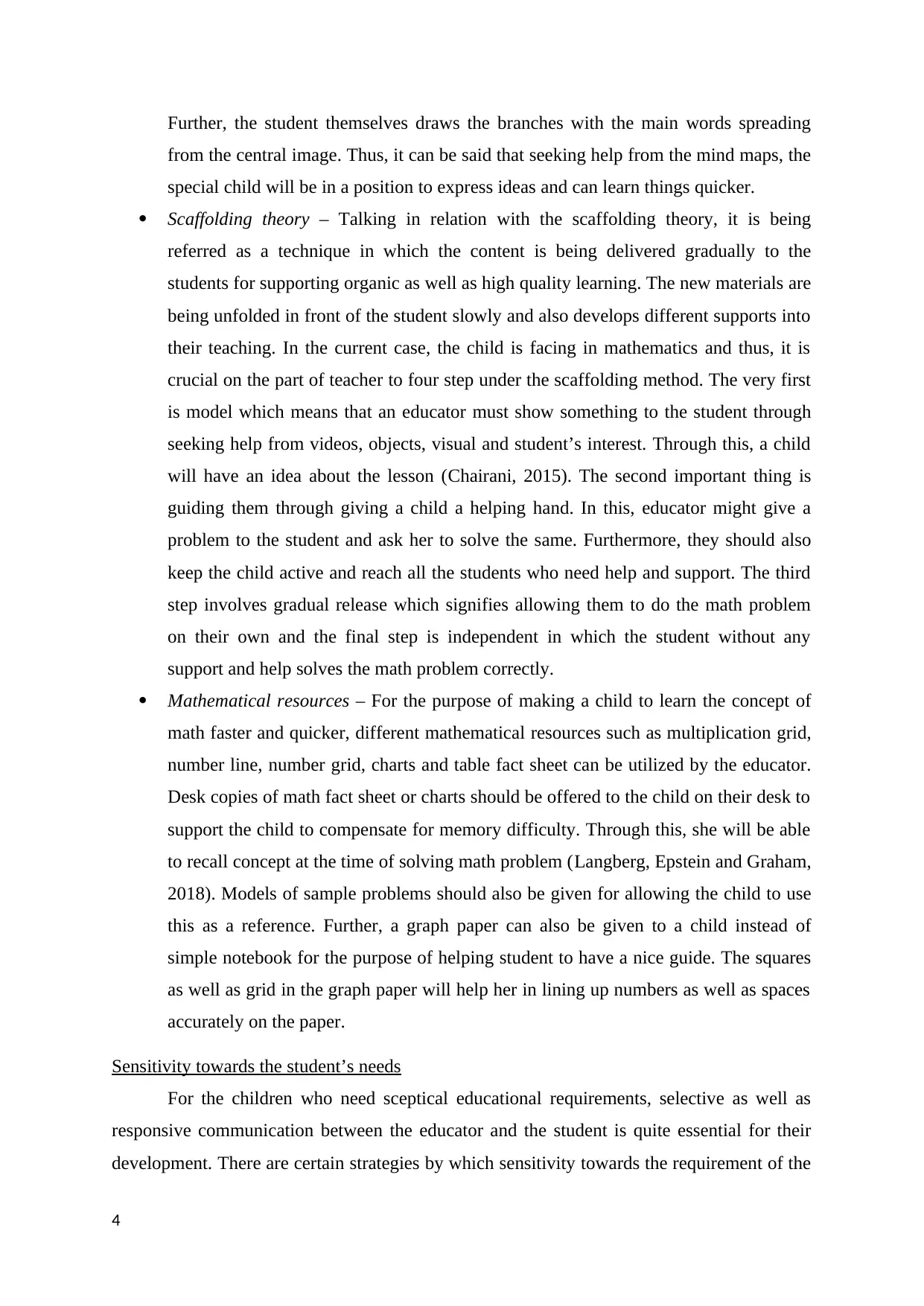
Further, the student themselves draws the branches with the main words spreading
from the central image. Thus, it can be said that seeking help from the mind maps, the
special child will be in a position to express ideas and can learn things quicker.
Scaffolding theory – Talking in relation with the scaffolding theory, it is being
referred as a technique in which the content is being delivered gradually to the
students for supporting organic as well as high quality learning. The new materials are
being unfolded in front of the student slowly and also develops different supports into
their teaching. In the current case, the child is facing in mathematics and thus, it is
crucial on the part of teacher to four step under the scaffolding method. The very first
is model which means that an educator must show something to the student through
seeking help from videos, objects, visual and student’s interest. Through this, a child
will have an idea about the lesson (Chairani, 2015). The second important thing is
guiding them through giving a child a helping hand. In this, educator might give a
problem to the student and ask her to solve the same. Furthermore, they should also
keep the child active and reach all the students who need help and support. The third
step involves gradual release which signifies allowing them to do the math problem
on their own and the final step is independent in which the student without any
support and help solves the math problem correctly.
Mathematical resources – For the purpose of making a child to learn the concept of
math faster and quicker, different mathematical resources such as multiplication grid,
number line, number grid, charts and table fact sheet can be utilized by the educator.
Desk copies of math fact sheet or charts should be offered to the child on their desk to
support the child to compensate for memory difficulty. Through this, she will be able
to recall concept at the time of solving math problem (Langberg, Epstein and Graham,
2018). Models of sample problems should also be given for allowing the child to use
this as a reference. Further, a graph paper can also be given to a child instead of
simple notebook for the purpose of helping student to have a nice guide. The squares
as well as grid in the graph paper will help her in lining up numbers as well as spaces
accurately on the paper.
Sensitivity towards the student’s needs
For the children who need sceptical educational requirements, selective as well as
responsive communication between the educator and the student is quite essential for their
development. There are certain strategies by which sensitivity towards the requirement of the
4
from the central image. Thus, it can be said that seeking help from the mind maps, the
special child will be in a position to express ideas and can learn things quicker.
Scaffolding theory – Talking in relation with the scaffolding theory, it is being
referred as a technique in which the content is being delivered gradually to the
students for supporting organic as well as high quality learning. The new materials are
being unfolded in front of the student slowly and also develops different supports into
their teaching. In the current case, the child is facing in mathematics and thus, it is
crucial on the part of teacher to four step under the scaffolding method. The very first
is model which means that an educator must show something to the student through
seeking help from videos, objects, visual and student’s interest. Through this, a child
will have an idea about the lesson (Chairani, 2015). The second important thing is
guiding them through giving a child a helping hand. In this, educator might give a
problem to the student and ask her to solve the same. Furthermore, they should also
keep the child active and reach all the students who need help and support. The third
step involves gradual release which signifies allowing them to do the math problem
on their own and the final step is independent in which the student without any
support and help solves the math problem correctly.
Mathematical resources – For the purpose of making a child to learn the concept of
math faster and quicker, different mathematical resources such as multiplication grid,
number line, number grid, charts and table fact sheet can be utilized by the educator.
Desk copies of math fact sheet or charts should be offered to the child on their desk to
support the child to compensate for memory difficulty. Through this, she will be able
to recall concept at the time of solving math problem (Langberg, Epstein and Graham,
2018). Models of sample problems should also be given for allowing the child to use
this as a reference. Further, a graph paper can also be given to a child instead of
simple notebook for the purpose of helping student to have a nice guide. The squares
as well as grid in the graph paper will help her in lining up numbers as well as spaces
accurately on the paper.
Sensitivity towards the student’s needs
For the children who need sceptical educational requirements, selective as well as
responsive communication between the educator and the student is quite essential for their
development. There are certain strategies by which sensitivity towards the requirement of the
4
⊘ This is a preview!⊘
Do you want full access?
Subscribe today to unlock all pages.

Trusted by 1+ million students worldwide
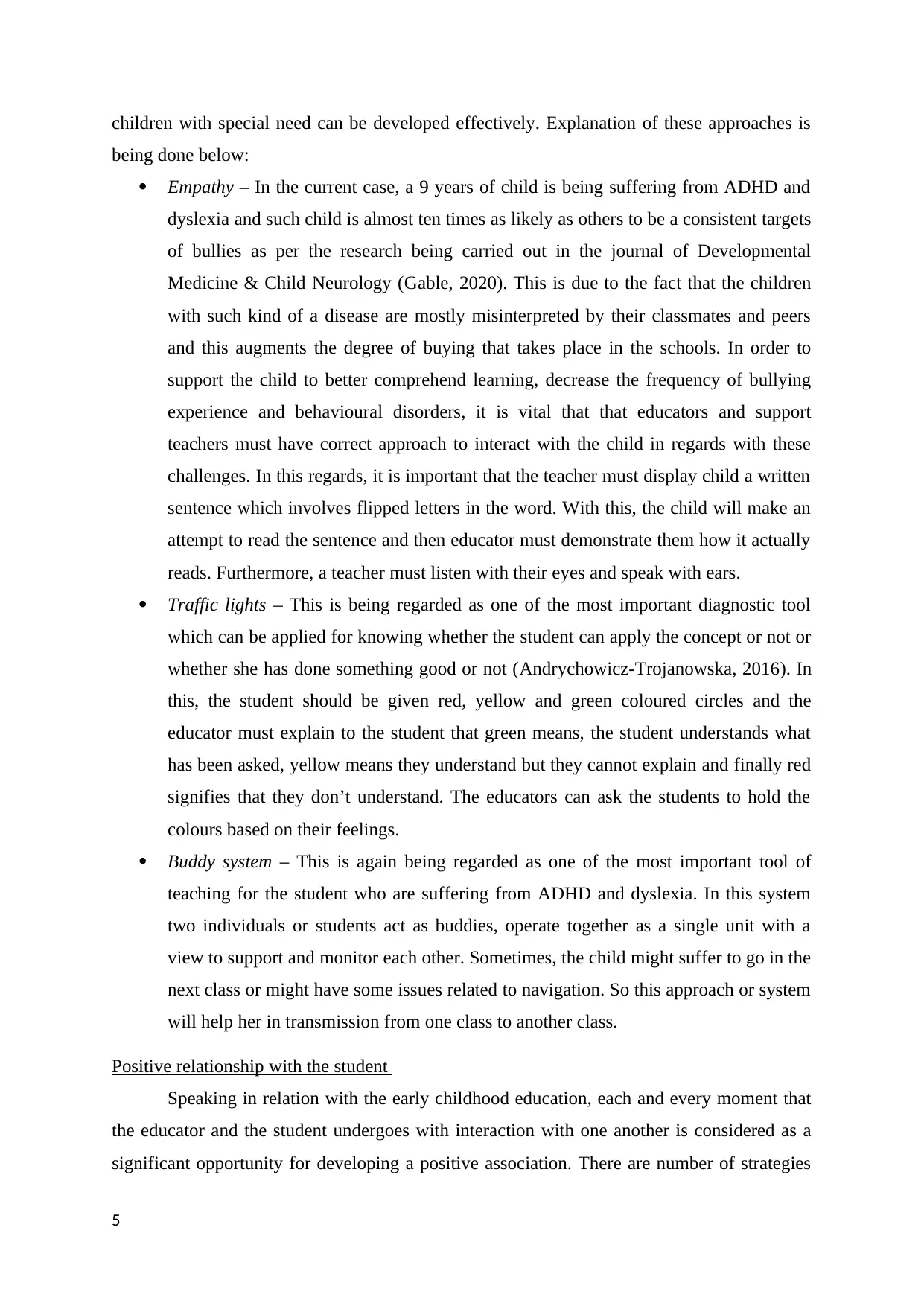
children with special need can be developed effectively. Explanation of these approaches is
being done below:
Empathy – In the current case, a 9 years of child is being suffering from ADHD and
dyslexia and such child is almost ten times as likely as others to be a consistent targets
of bullies as per the research being carried out in the journal of Developmental
Medicine & Child Neurology (Gable, 2020). This is due to the fact that the children
with such kind of a disease are mostly misinterpreted by their classmates and peers
and this augments the degree of buying that takes place in the schools. In order to
support the child to better comprehend learning, decrease the frequency of bullying
experience and behavioural disorders, it is vital that that educators and support
teachers must have correct approach to interact with the child in regards with these
challenges. In this regards, it is important that the teacher must display child a written
sentence which involves flipped letters in the word. With this, the child will make an
attempt to read the sentence and then educator must demonstrate them how it actually
reads. Furthermore, a teacher must listen with their eyes and speak with ears.
Traffic lights – This is being regarded as one of the most important diagnostic tool
which can be applied for knowing whether the student can apply the concept or not or
whether she has done something good or not (Andrychowicz-Trojanowska, 2016). In
this, the student should be given red, yellow and green coloured circles and the
educator must explain to the student that green means, the student understands what
has been asked, yellow means they understand but they cannot explain and finally red
signifies that they don’t understand. The educators can ask the students to hold the
colours based on their feelings.
Buddy system – This is again being regarded as one of the most important tool of
teaching for the student who are suffering from ADHD and dyslexia. In this system
two individuals or students act as buddies, operate together as a single unit with a
view to support and monitor each other. Sometimes, the child might suffer to go in the
next class or might have some issues related to navigation. So this approach or system
will help her in transmission from one class to another class.
Positive relationship with the student
Speaking in relation with the early childhood education, each and every moment that
the educator and the student undergoes with interaction with one another is considered as a
significant opportunity for developing a positive association. There are number of strategies
5
being done below:
Empathy – In the current case, a 9 years of child is being suffering from ADHD and
dyslexia and such child is almost ten times as likely as others to be a consistent targets
of bullies as per the research being carried out in the journal of Developmental
Medicine & Child Neurology (Gable, 2020). This is due to the fact that the children
with such kind of a disease are mostly misinterpreted by their classmates and peers
and this augments the degree of buying that takes place in the schools. In order to
support the child to better comprehend learning, decrease the frequency of bullying
experience and behavioural disorders, it is vital that that educators and support
teachers must have correct approach to interact with the child in regards with these
challenges. In this regards, it is important that the teacher must display child a written
sentence which involves flipped letters in the word. With this, the child will make an
attempt to read the sentence and then educator must demonstrate them how it actually
reads. Furthermore, a teacher must listen with their eyes and speak with ears.
Traffic lights – This is being regarded as one of the most important diagnostic tool
which can be applied for knowing whether the student can apply the concept or not or
whether she has done something good or not (Andrychowicz-Trojanowska, 2016). In
this, the student should be given red, yellow and green coloured circles and the
educator must explain to the student that green means, the student understands what
has been asked, yellow means they understand but they cannot explain and finally red
signifies that they don’t understand. The educators can ask the students to hold the
colours based on their feelings.
Buddy system – This is again being regarded as one of the most important tool of
teaching for the student who are suffering from ADHD and dyslexia. In this system
two individuals or students act as buddies, operate together as a single unit with a
view to support and monitor each other. Sometimes, the child might suffer to go in the
next class or might have some issues related to navigation. So this approach or system
will help her in transmission from one class to another class.
Positive relationship with the student
Speaking in relation with the early childhood education, each and every moment that
the educator and the student undergoes with interaction with one another is considered as a
significant opportunity for developing a positive association. There are number of strategies
5
Paraphrase This Document
Need a fresh take? Get an instant paraphrase of this document with our AI Paraphraser
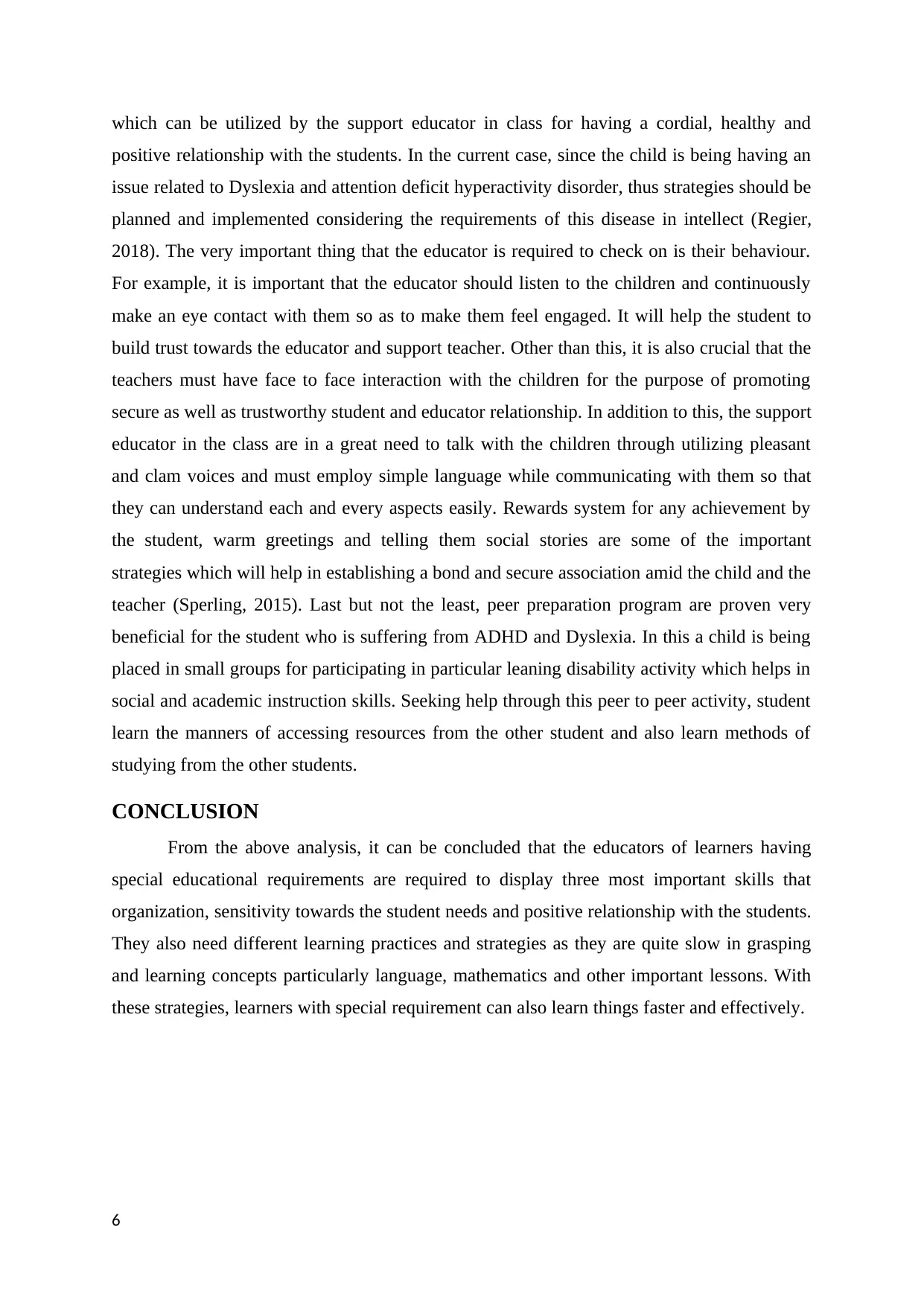
which can be utilized by the support educator in class for having a cordial, healthy and
positive relationship with the students. In the current case, since the child is being having an
issue related to Dyslexia and attention deficit hyperactivity disorder, thus strategies should be
planned and implemented considering the requirements of this disease in intellect (Regier,
2018). The very important thing that the educator is required to check on is their behaviour.
For example, it is important that the educator should listen to the children and continuously
make an eye contact with them so as to make them feel engaged. It will help the student to
build trust towards the educator and support teacher. Other than this, it is also crucial that the
teachers must have face to face interaction with the children for the purpose of promoting
secure as well as trustworthy student and educator relationship. In addition to this, the support
educator in the class are in a great need to talk with the children through utilizing pleasant
and clam voices and must employ simple language while communicating with them so that
they can understand each and every aspects easily. Rewards system for any achievement by
the student, warm greetings and telling them social stories are some of the important
strategies which will help in establishing a bond and secure association amid the child and the
teacher (Sperling, 2015). Last but not the least, peer preparation program are proven very
beneficial for the student who is suffering from ADHD and Dyslexia. In this a child is being
placed in small groups for participating in particular leaning disability activity which helps in
social and academic instruction skills. Seeking help through this peer to peer activity, student
learn the manners of accessing resources from the other student and also learn methods of
studying from the other students.
CONCLUSION
From the above analysis, it can be concluded that the educators of learners having
special educational requirements are required to display three most important skills that
organization, sensitivity towards the student needs and positive relationship with the students.
They also need different learning practices and strategies as they are quite slow in grasping
and learning concepts particularly language, mathematics and other important lessons. With
these strategies, learners with special requirement can also learn things faster and effectively.
6
positive relationship with the students. In the current case, since the child is being having an
issue related to Dyslexia and attention deficit hyperactivity disorder, thus strategies should be
planned and implemented considering the requirements of this disease in intellect (Regier,
2018). The very important thing that the educator is required to check on is their behaviour.
For example, it is important that the educator should listen to the children and continuously
make an eye contact with them so as to make them feel engaged. It will help the student to
build trust towards the educator and support teacher. Other than this, it is also crucial that the
teachers must have face to face interaction with the children for the purpose of promoting
secure as well as trustworthy student and educator relationship. In addition to this, the support
educator in the class are in a great need to talk with the children through utilizing pleasant
and clam voices and must employ simple language while communicating with them so that
they can understand each and every aspects easily. Rewards system for any achievement by
the student, warm greetings and telling them social stories are some of the important
strategies which will help in establishing a bond and secure association amid the child and the
teacher (Sperling, 2015). Last but not the least, peer preparation program are proven very
beneficial for the student who is suffering from ADHD and Dyslexia. In this a child is being
placed in small groups for participating in particular leaning disability activity which helps in
social and academic instruction skills. Seeking help through this peer to peer activity, student
learn the manners of accessing resources from the other student and also learn methods of
studying from the other students.
CONCLUSION
From the above analysis, it can be concluded that the educators of learners having
special educational requirements are required to display three most important skills that
organization, sensitivity towards the student needs and positive relationship with the students.
They also need different learning practices and strategies as they are quite slow in grasping
and learning concepts particularly language, mathematics and other important lessons. With
these strategies, learners with special requirement can also learn things faster and effectively.
6
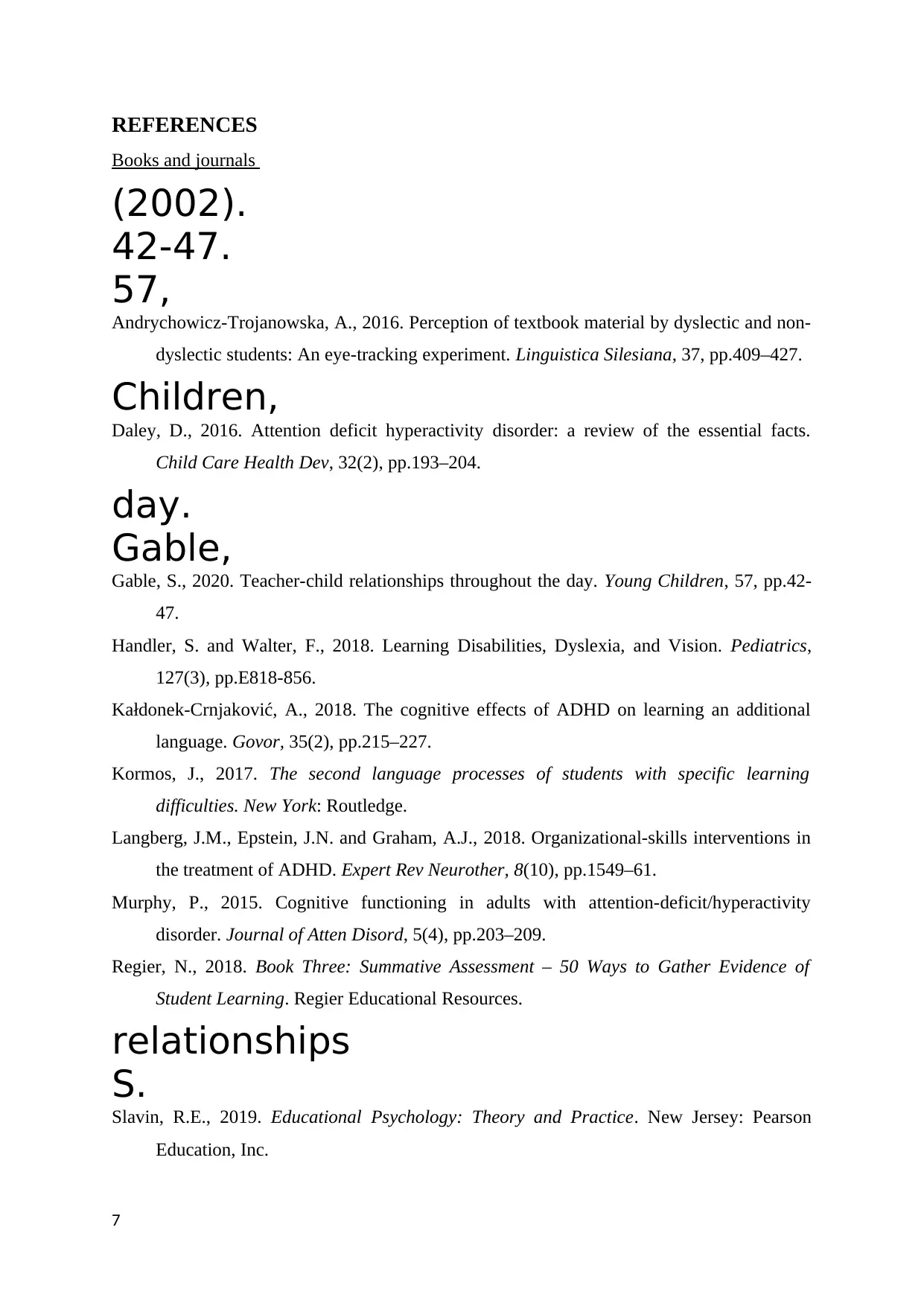
REFERENCES
Books and journals
(2002).
42-47.
57,
Andrychowicz-Trojanowska, A., 2016. Perception of textbook material by dyslectic and non-
dyslectic students: An eye-tracking experiment. Linguistica Silesiana, 37, pp.409–427.
Children,
Daley, D., 2016. Attention deficit hyperactivity disorder: a review of the essential facts.
Child Care Health Dev, 32(2), pp.193–204.
day.
Gable,
Gable, S., 2020. Teacher-child relationships throughout the day. Young Children, 57, pp.42-
47.
Handler, S. and Walter, F., 2018. Learning Disabilities, Dyslexia, and Vision. Pediatrics,
127(3), pp.E818-856.
Kałdonek-Crnjaković, A., 2018. The cognitive effects of ADHD on learning an additional
language. Govor, 35(2), pp.215–227.
Kormos, J., 2017. The second language processes of students with specific learning
difficulties. New York: Routledge.
Langberg, J.M., Epstein, J.N. and Graham, A.J., 2018. Organizational-skills interventions in
the treatment of ADHD. Expert Rev Neurother, 8(10), pp.1549–61.
Murphy, P., 2015. Cognitive functioning in adults with attention-deficit/hyperactivity
disorder. Journal of Atten Disord, 5(4), pp.203–209.
Regier, N., 2018. Book Three: Summative Assessment – 50 Ways to Gather Evidence of
Student Learning. Regier Educational Resources.
relationships
S.
Slavin, R.E., 2019. Educational Psychology: Theory and Practice. New Jersey: Pearson
Education, Inc.
7
Books and journals
(2002).
42-47.
57,
Andrychowicz-Trojanowska, A., 2016. Perception of textbook material by dyslectic and non-
dyslectic students: An eye-tracking experiment. Linguistica Silesiana, 37, pp.409–427.
Children,
Daley, D., 2016. Attention deficit hyperactivity disorder: a review of the essential facts.
Child Care Health Dev, 32(2), pp.193–204.
day.
Gable,
Gable, S., 2020. Teacher-child relationships throughout the day. Young Children, 57, pp.42-
47.
Handler, S. and Walter, F., 2018. Learning Disabilities, Dyslexia, and Vision. Pediatrics,
127(3), pp.E818-856.
Kałdonek-Crnjaković, A., 2018. The cognitive effects of ADHD on learning an additional
language. Govor, 35(2), pp.215–227.
Kormos, J., 2017. The second language processes of students with specific learning
difficulties. New York: Routledge.
Langberg, J.M., Epstein, J.N. and Graham, A.J., 2018. Organizational-skills interventions in
the treatment of ADHD. Expert Rev Neurother, 8(10), pp.1549–61.
Murphy, P., 2015. Cognitive functioning in adults with attention-deficit/hyperactivity
disorder. Journal of Atten Disord, 5(4), pp.203–209.
Regier, N., 2018. Book Three: Summative Assessment – 50 Ways to Gather Evidence of
Student Learning. Regier Educational Resources.
relationships
S.
Slavin, R.E., 2019. Educational Psychology: Theory and Practice. New Jersey: Pearson
Education, Inc.
7
⊘ This is a preview!⊘
Do you want full access?
Subscribe today to unlock all pages.

Trusted by 1+ million students worldwide
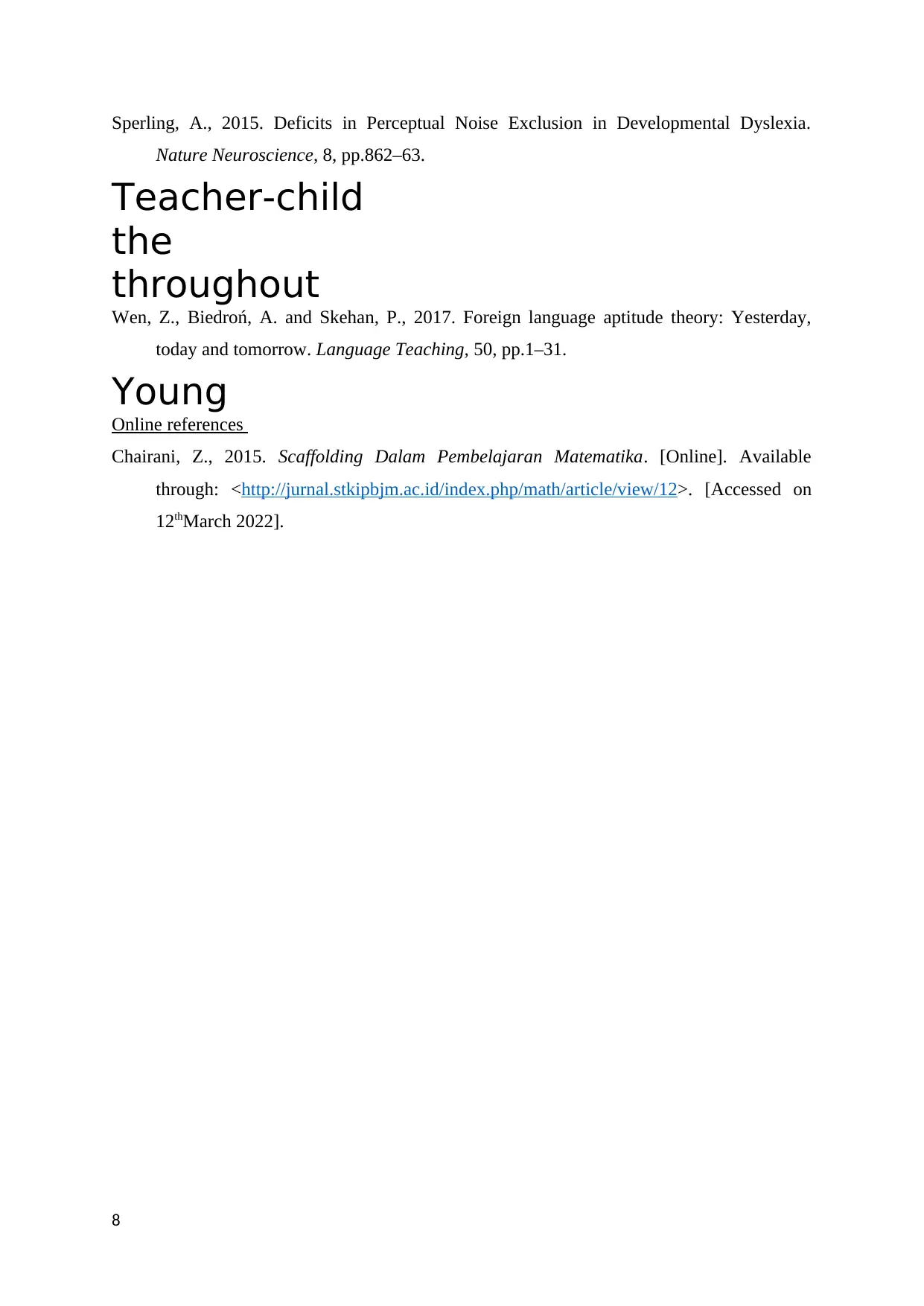
Sperling, A., 2015. Deficits in Perceptual Noise Exclusion in Developmental Dyslexia.
Nature Neuroscience, 8, pp.862–63.
Teacher-child
the
throughout
Wen, Z., Biedroń, A. and Skehan, P., 2017. Foreign language aptitude theory: Yesterday,
today and tomorrow. Language Teaching, 50, pp.1–31.
Young
Online references
Chairani, Z., 2015. Scaffolding Dalam Pembelajaran Matematika. [Online]. Available
through: <http://jurnal.stkipbjm.ac.id/index.php/math/article/view/12>. [Accessed on
12thMarch 2022].
8
Nature Neuroscience, 8, pp.862–63.
Teacher-child
the
throughout
Wen, Z., Biedroń, A. and Skehan, P., 2017. Foreign language aptitude theory: Yesterday,
today and tomorrow. Language Teaching, 50, pp.1–31.
Young
Online references
Chairani, Z., 2015. Scaffolding Dalam Pembelajaran Matematika. [Online]. Available
through: <http://jurnal.stkipbjm.ac.id/index.php/math/article/view/12>. [Accessed on
12thMarch 2022].
8
1 out of 10
Related Documents
Your All-in-One AI-Powered Toolkit for Academic Success.
+13062052269
info@desklib.com
Available 24*7 on WhatsApp / Email
![[object Object]](/_next/static/media/star-bottom.7253800d.svg)
Unlock your academic potential
Copyright © 2020–2025 A2Z Services. All Rights Reserved. Developed and managed by ZUCOL.





